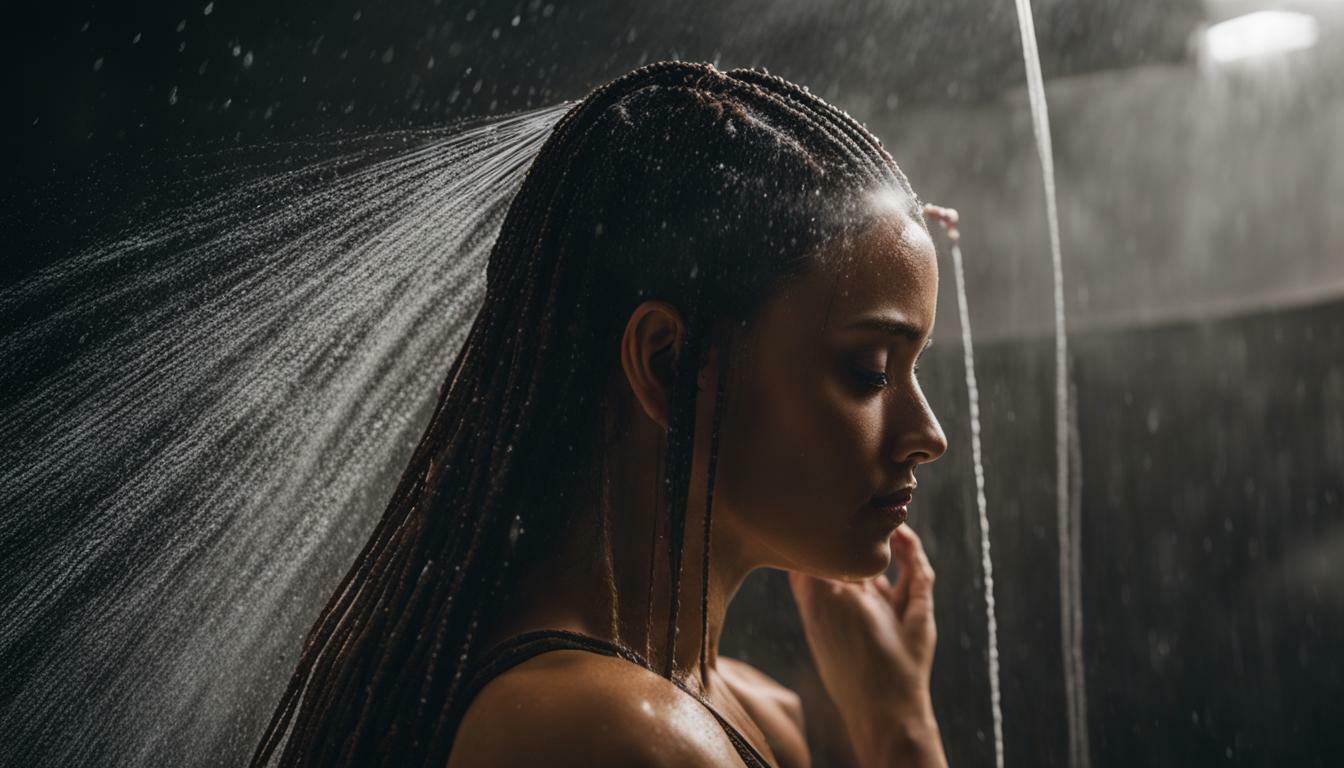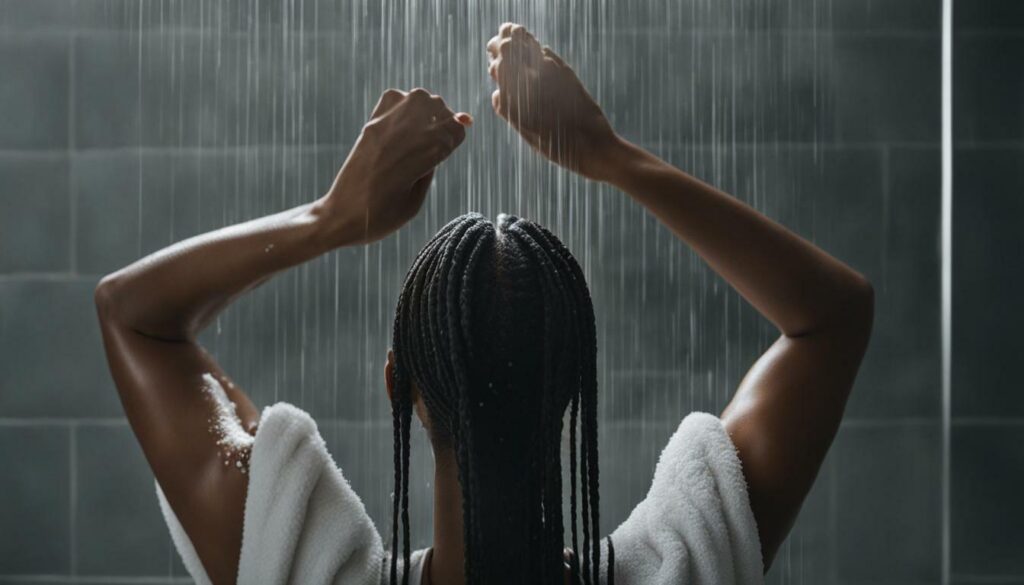
Showering with braids is possible, but it’s important to take certain precautions to protect your hair. When your braids get wet, there are potential risks such as fungal growth, hair damage, frizz, and unraveling. To ensure the health and neatness of your braids, it’s essential to understand how to properly care for them while showering.
- Thoroughly dry your braids after showering to prevent fungal growth.
- Handle wet braids with care to avoid hair damage.
- Wetting your braids before swimming can help prevent chlorine damage.
- Choose braided styles that can handle water if you intend to swim.
- Wash your braids without ruining them by using diluted shampoo and conditioner.
Maintaining and Protecting Braids During Showers
When showering with braids, it’s crucial to take steps to maintain and protect your hair. Wetting your braids can pose several risks, including fungal growth, hair damage, frizz, and unraveling. The warm, damp environment created by wet braids is the perfect breeding ground for mold and mildew, so it’s essential to thoroughly dry your braids after showering to prevent any fungal growth.
Wet hair is more prone to breakage, so it’s important to handle wet braids with care. Avoid excessive rubbing or pulling when washing or drying your braids to prevent any hair damage. Another common issue with wet braids is frizz. The water causes your natural hair to swell and expand, resulting in frizzy hair once it dries. To combat this, you can gently pat your braids with a towel to soak up excess water and allow them to air dry or use a blow dryer on a cool setting.
“Wetting your braids beforehand with clean water can help prevent chlorine damage from swimming.”
If you plan to swim with braids, it’s best to choose a braided style that can handle water. Opt for small to medium-sized box braids, cornrows styled into a bun, Ghana braids, or lemonade braids, as these are generally more resistant to water damage. Before entering the pool, wetting your braids with clean water can create a protective barrier against chlorine damage. After swimming, rinsing your braids with clean water and, if desired, washing them with shampoo followed by a leave-in conditioner can help maintain their health and appearance.
When it comes to washing your braids, you can still cleanse them without causing damage. Dilute shampoo with water and gently apply it to your roots, massaging to remove any buildup or excess oils. Rinse thoroughly and repeat if necessary. After shampooing, apply conditioner to your braids, massage it in, and rinse. To dry your braids, use a towel to absorb excess water and then allow them to air dry or use a blow dryer on a cool setting. It’s important to avoid tying up your braids in a ponytail or bun while they’re still wet, as this can lead to breakage. If your braids feel dry, you can lightly mist them with a leave-in conditioner before styling as usual.

Summary
Showering with braids is possible as long as you take the necessary precautions to maintain and protect your hair. Thoroughly drying your braids after showering is crucial to prevent any fungal growth. Handling wet braids with care can help prevent hair damage and minimize frizz. Choosing a braided style that can handle water and taking steps to protect your braids while swimming can also help maintain their health. Proper washing techniques, including diluting shampoo, applying conditioner, and gentle drying, can ensure your braids stay clean and undamaged. By following these tips, you can shower with braids while keeping them healthy and neat.
Tips for Showering with Braids
Follow these tips to safely shower with braids and keep your hair healthy and intact.
If you want to swim with braids, it’s important to choose a style that can handle water. Opt for small to medium box braids, cornrows into a bun, Ghana braids, or lemonade braids. These styles are less likely to unravel or be damaged by water. Before swimming, wet your braids with clean water to minimize the potential for chlorine damage. After swimming, rinse your braids with clean water and consider washing them with shampoo followed by leave-in conditioner for added moisture.
When it comes to washing braids, you can do so without ruining them. Dilute shampoo with water and apply it to your roots, gently massaging to remove buildup and excess oils. Rinse thoroughly and repeat if necessary. After shampooing, apply conditioner to your braids, ensuring it reaches all the way to the ends. Massage the conditioner in and rinse well. To dry your braids, use a towel to gently soak up excess water, being careful not to rub or twist them harshly. Then, either air dry them or use a blow dryer on a cool setting.
It’s important to avoid tying up your braids in a ponytail or bun while they are still wet, as this can cause damage and breakage. Allow them to air dry or use a cool blow dryer until they are completely dry. If your braids feel dry after showering, you can mist them lightly with a leave-in conditioner to add moisture. Finally, style your braids as desired, being mindful of not pulling or tugging on them too tightly to avoid unnecessary stress on your hair.

| Risks | Precautions |
|---|---|
| Fungal growth | Thoroughly dry braids after showering |
| Hair damage | Handle wet braids with care |
| Frizz | Avoid rubbing or twisting wet braids vigorously |
| Unraveling | Ensure braids are secure and avoid excessive contact with water |
Conclusion
Showering with braids is possible as long as you take the necessary precautions to protect and maintain them properly. When your braids get wet, there are potential risks such as fungal growth, hair damage, frizz, and unraveling. To prevent fungal growth, it’s essential to thoroughly dry your braids after showering. Wet hair is more prone to breakage, so handle wet braids with care to avoid damage. Additionally, water can cause natural hair to become frizzy, so it’s important to take steps to minimize frizz.
If you want to swim with braids, choose a style that can handle water, such as small to medium box braids or cornrows into a bun. Wetting your braids with clean water before swimming can also help prevent chlorine damage. After swimming, rinse your braids with clean water and consider washing them with shampoo and applying a leave-in conditioner. Wearing a swim cap can provide some protection, but may not keep all the water out.
When washing your braids, you can do so without ruining them. Dilute shampoo with water and gently massage it into your roots to remove buildup and excess oils. Rinse thoroughly and repeat if necessary. Apply conditioner to your braids, massage it in, and rinse. To dry your braids, gently towel-dry to remove excess water and then allow them to air dry or use a blow dryer on a cool setting. Avoid tying up wet braids to prevent damage, and if your braids feel dry, mist them lightly with a leave-in conditioner. Finally, style your braids as usual.
In summary, with the proper precautions, you can shower with braids and maintain their health and neatness. By following these steps and taking care of your braids, you can enjoy the convenience of showering without compromising the condition of your hair.
FAQ
Can you shower with braids?
Yes, you can shower with braids, but there are precautions you should take to protect your braids from potential risks.
What are the risks of showering with braids?
The risks of showering with braids include fungal growth, hair damage, frizz, and unraveling.
How can you prevent fungal growth when showering with braids?
To prevent fungal growth, thoroughly dry your braids after showering to eliminate any wet, warm, enclosed areas that can create an environment for mold and mildew to grow.
How can you prevent hair damage while showering with braids?
To prevent hair damage, handle wet braids with care and avoid excessive pulling or tugging.
Why do braids get frizzy when showered?
Braids can get frizzy when showered because the water causes natural hair to swell and expand, leading to frizz as it dries.
How can you prevent unraveling when showering with braids?
To prevent unraveling, make sure your braids are secure and avoid exposing them to excessive water.
What braided styles are suitable for showering?
Braided styles that can handle water include small to medium box braids, cornrows into a bun, Ghana braids, and lemonade braids.
How can you protect your braids while swimming?
To protect your braids while swimming, wet them beforehand with clean water and rinse them with clean water after swimming. Wearing a swim cap is also an option.
How can you wash braids without ruining them?
To wash braids without ruining them, dilute shampoo with water and apply it to the roots, massaging gently. Rinse thoroughly and repeat if needed. Apply conditioner to the braids, massage it in, and rinse.
How should you dry your braids after showering?
To dry your braids, use a towel to soak up excess water and then air dry them or use a blow dryer on a cool setting. Avoid tying up wet braids in a ponytail or bun to prevent damage.
How can you maintain the health and neatness of your braids while showering?
To maintain the health and neatness of your braids while showering, follow the recommended precautions, washing techniques, and drying methods. Style your braids as usual once they are dry.






